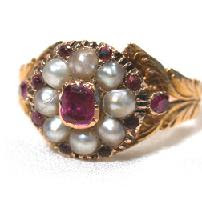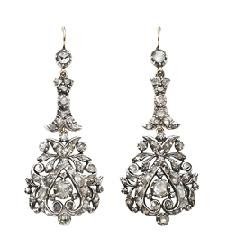I love when I have to research jewelry for a story. One of my favorite sources is Three Graces Antique Jewelry, a good place for research and fantasy shopping. Most of the images in this post are from Three Graces. I based a ring in one of my books on this one, substituting sapphires for the rubies.
I’ve also learned that for the heroine on a budget like me, there were options that were less expensive than gold and gemstones.

 I remember seeing the term “pinchbeck” in Georgette Heyer novel and wondered what it meant. It turns out it’s an alloy of copper and zinc invented by Christopher Pinchbeck (1670-1732) and used extensively to make durable jewelry that was less expensive than gold. The earrings to the left are gold, to the right, pinchbeck, both early 19th century. I think both are very pretty! One could wear these to a ball, with a pretty white gown if one were young, or with more vibrant colors if older (I love gold with green).
I remember seeing the term “pinchbeck” in Georgette Heyer novel and wondered what it meant. It turns out it’s an alloy of copper and zinc invented by Christopher Pinchbeck (1670-1732) and used extensively to make durable jewelry that was less expensive than gold. The earrings to the left are gold, to the right, pinchbeck, both early 19th century. I think both are very pretty! One could wear these to a ball, with a pretty white gown if one were young, or with more vibrant colors if older (I love gold with green).

 The term “paste” used to make me think of plastic (ugh!) but it actually refers to cut leaded glass faceted to resemble real gemstones. Being softer, it was trickier to cut. And some of it is very pretty as well. Here I have several sets of earrings, diamonds above, paste below. Frankly, I cannot tell the difference! Any of them would be just the thing for a night with my lover at the opera.
The term “paste” used to make me think of plastic (ugh!) but it actually refers to cut leaded glass faceted to resemble real gemstones. Being softer, it was trickier to cut. And some of it is very pretty as well. Here I have several sets of earrings, diamonds above, paste below. Frankly, I cannot tell the difference! Any of them would be just the thing for a night with my lover at the opera. 
 The term “parure” refers to a set of matching jewelry. The first is amethyst, the other is emerald-colored paste. I think these parures would be great for a presentation at court. Since the combination of high waists and hoop skirts couldn’t flatter any figure, pretty trinkets like this would help to bring the eye toward the face, instead.
The term “parure” refers to a set of matching jewelry. The first is amethyst, the other is emerald-colored paste. I think these parures would be great for a presentation at court. Since the combination of high waists and hoop skirts couldn’t flatter any figure, pretty trinkets like this would help to bring the eye toward the face, instead. 
Here are some more period baubles. Can you guess what period they are and can you tell the paste and pinchbeck from the real? (Don’t worry if you can’t–I was very surprised by some of them.) Where would you wear them?







